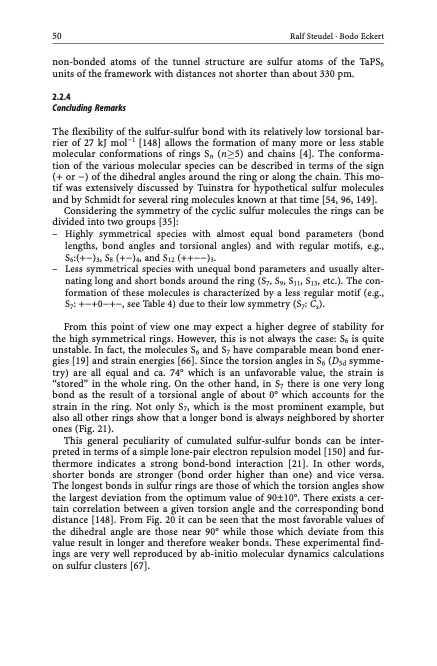
PDF Publication Title:
Text from PDF Page: 060
50 Ralf Steudel · Bodo Eckert non-bonded atoms of the tunnel structure are sulfur atoms of the TaPS6 units of the framework with distances not shorter than about 330 pm. 2.2.4 Concluding Remarks The flexibility of the sulfur-sulfur bond with its relatively low torsional bar- rier of 27 kJ mol1 [148] allows the formation of many more or less stable molecular conformations of rings Sn (n5) and chains [4]. The conforma- tion of the various molecular species can be described in terms of the sign (+ or ) of the dihedral angles around the ring or along the chain. This mo- tif was extensively discussed by Tuinstra for hypothetical sulfur molecules and by Schmidt for several ring molecules known at that time [54, 96, 149]. Considering the symmetry of the cyclic sulfur molecules the rings can be divided into two groups [35]: – Highly symmetrical species with almost equal bond parameters (bond lengths, bond angles and torsional angles) and with regular motifs, e.g., S6:(+)3, S8 (+)4, and S12 (++)3. – Less symmetrical species with unequal bond parameters and usually alter- nating long and short bonds around the ring (S7, S9, S11, S13, etc.). The con- formation of these molecules is characterized by a less regular motif (e.g., S7: ++0+, see Table 4) due to their low symmetry (S7: Cs). From this point of view one may expect a higher degree of stability for the high symmetrical rings. However, this is not always the case: S6 is quite unstable. In fact, the molecules S6 and S7 have comparable mean bond ener- gies [19] and strain energies [66]. Since the torsion angles in S6 (D3d symme- try) are all equal and ca. 74 which is an unfavorable value, the strain is “stored” in the whole ring. On the other hand, in S7 there is one very long bond as the result of a torsional angle of about 0 which accounts for the strain in the ring. Not only S7, which is the most prominent example, but also all other rings show that a longer bond is always neighbored by shorter ones (Fig. 21). This general peculiarity of cumulated sulfur-sulfur bonds can be inter- preted in terms of a simple lone-pair electron repulsion model [150] and fur- thermore indicates a strong bond-bond interaction [21]. In other words, shorter bonds are stronger (bond order higher than one) and vice versa. The longest bonds in sulfur rings are those of which the torsion angles show the largest deviation from the optimum value of 90€10. There exists a cer- tain correlation between a given torsion angle and the corresponding bond distance [148]. From Fig. 20 it can be seen that the most favorable values of the dihedral angle are those near 90 while those which deviate from this value result in longer and therefore weaker bonds. These experimental find- ings are very well reproduced by ab-initio molecular dynamics calculations on sulfur clusters [67].PDF Image | Topics in Current Chemistry

PDF Search Title:
Topics in Current ChemistryOriginal File Name Searched:
Elemental-Sulfur-und-Sulfur-Rich-Compounds-I.pdfDIY PDF Search: Google It | Yahoo | Bing
Sulfur Deposition on Carbon Nanofibers using Supercritical CO2 Sulfur Deposition on Carbon Nanofibers using Supercritical CO2. Gamma sulfur also known as mother of pearl sulfur and nacreous sulfur... More Info
CO2 Organic Rankine Cycle Experimenter Platform The supercritical CO2 phase change system is both a heat pump and organic rankine cycle which can be used for those purposes and as a supercritical extractor for advanced subcritical and supercritical extraction technology. Uses include producing nanoparticles, precious metal CO2 extraction, lithium battery recycling, and other applications... More Info
| CONTACT TEL: 608-238-6001 Email: greg@infinityturbine.com | RSS | AMP |